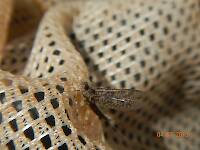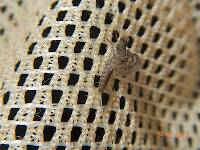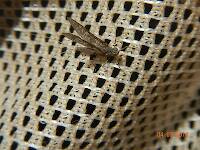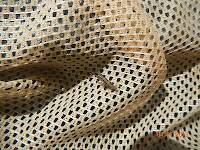
Salmonflies
Pteronarcys californica
The giant Salmonflies of the Western mountains are legendary for their proclivity to elicit consistent dry-fly action and ferocious strikes.
Featured on the forum

I caught this tiny larva without a case, but it seems to key pretty clearly to to Glossosomatidae. From there, the lack of sclerites on the mesonotum points to either Glossosoma or Anagapetus. Although it's difficult to see in a 2D image from the microscope, it's pretty clear in the live 3D view that the pronotum is only excised about 1/3 of its length to accommodate the forecoxa, not 2/3, which points to Glossosoma at Couplet 5 of the Key to Genera of Glossosomatidae Larvae.

Troutnut is a project started in 2003 by salmonid ecologist Jason "Troutnut" Neuswanger to help anglers and
fly tyers unabashedly embrace the entomological side of the sport. Learn more about Troutnut or
support the project for an enhanced experience here.
Taxon on Jul 25, 2006July 25th, 2006, 6:51 pm EDT
Jason-
Here's a mayfly that's really got me puzzled. The abdominal banding makes me think Siphlonurus, but it's got the strangest wings. Have never seen such round wings. What do you think?
Here's a mayfly that's really got me puzzled. The abdominal banding makes me think Siphlonurus, but it's got the strangest wings. Have never seen such round wings. What do you think?
Troutnut on Jul 26, 2006July 26th, 2006, 2:13 am EDT
It looks like Siphlonurus to me. I don't see what's so strange about the wings -- it looks like they're just photographed at an unusual angle. They're sticking up toward the camera.
Jason Neuswanger, Ph.D.
Troutnut and salmonid ecologist
Troutnut and salmonid ecologist
Taxon on Jul 26, 2006July 26th, 2006, 6:36 am EDT
Jason-
Thought the wing appearance might just be an illusion due to the angle, but wanted an unbiased second opinion. Thanks.
Also, thanks for fixing my link. I am used to using the "url=" rather than "link url=" syntax, and just couldn't get it to work. Should have peeked at your Markup Syntax page, but had sort of forgotten it was there.
Thought the wing appearance might just be an illusion due to the angle, but wanted an unbiased second opinion. Thanks.
Also, thanks for fixing my link. I am used to using the "url=" rather than "link url=" syntax, and just couldn't get it to work. Should have peeked at your Markup Syntax page, but had sort of forgotten it was there.
Flymedic on Aug 21, 2006August 21st, 2006, 7:24 am EDT
Is this mayfly known to the Northeast? It looks like one that was hatching here in maine last week and I had never seen one. About the size of a hex?
Taxon on Aug 21, 2006August 21st, 2006, 10:12 am EDT
Flymedic-
It's funny you should ask. I saw your posting on FFO earlier today, and immediately thought Siphlonurus, but couldn't remember where I had seen the photo of one like that.
In any event, yes you have at least (7) Siphlonurus species in Maine. However, I don't know which particular Siphlonurus species is pictured in that photo.
It's funny you should ask. I saw your posting on FFO earlier today, and immediately thought Siphlonurus, but couldn't remember where I had seen the photo of one like that.
In any event, yes you have at least (7) Siphlonurus species in Maine. However, I don't know which particular Siphlonurus species is pictured in that photo.
Flymedic on Aug 22, 2006August 22nd, 2006, 5:54 am EDT
A question about nymph ID. I can tell between a stone, mayfly, caddis, ect. but as to what color or type they will become i'm unclear. Is there any "easy" way to tell. Perhaps by there color or bands on the body?
Taxon on Aug 22, 2006August 22nd, 2006, 10:54 am EDT
Flymedic-
Not sure I fully understand what you mean by "what color or type they will become." However, I will assume you mean that you would not only like to be able to identify aquatic insect larvae to Order, but would also like to be able to identify them to lower taxonomic levels like Family, Genus or Species.
There are numerous clues (keys) for doing so, but color and banding are probably among the least significant. Larval shape would certainly be more significant, especially for identification to Family.
Is this what you were asking?
Not sure I fully understand what you mean by "what color or type they will become." However, I will assume you mean that you would not only like to be able to identify aquatic insect larvae to Order, but would also like to be able to identify them to lower taxonomic levels like Family, Genus or Species.
There are numerous clues (keys) for doing so, but color and banding are probably among the least significant. Larval shape would certainly be more significant, especially for identification to Family.
Is this what you were asking?
Flymedic on Aug 27, 2006August 27th, 2006, 12:21 am EDT
I think an easy way to ask would be if I find a mayfly nymph and want to know if it will become a BWO or Cayhill is there an easy way to do so.
Troutnut on Aug 27, 2006August 27th, 2006, 5:19 am EDT
if I find a mayfly nymph and want to know if it will become a BWO or Cayhill is there an easy way to do so.
Not really. In large part it's because a BWO can come from several different types of nymphs. Cahills usually come from clinger nymphs, but there are many types of those, and some aren't called cahills once they hatch. There are several common names for each species and several species for each common name, which makes these kind of predictions hard. Check out my editorial on Latin names to see more about the complications common names create.
There are a FEW things you can easily say. For example, if the nymph is a long yellowish burrower, it's going to hatch into some really long-bodied mayfly, like a Hex or a brown drake, yellow drake, or green drake.
Still, that's not terribly helpful. It's much, much easier to just learn to recognize the major species from your area. You've hit on one of the main reasons for doing so: because it helps you figure out what a nymph will hatch into. Or, if you have an adult, it helps you figure out what kind of nymph to fish while it's hatching.
Hopefully this site makes them a bit easier to learn.
Jason Neuswanger, Ph.D.
Troutnut and salmonid ecologist
Troutnut and salmonid ecologist
Taxon on Aug 27, 2006August 27th, 2006, 5:24 am EDT
Flymedic-
There are more mayflies called BWO than one can shake a stick at, and the same can be said of Cahill. However, in the case of BWO, all are either in family Baetidae (Small Minnow Mayflies), or in family Ephemerellidae (Spiny Crawler Mayflies). And in the case of Cahill, they are all in family Heptageniidae (Flatheaded Mayflies).
And, it is relatively easy to distinguish between the mayflies in these three families, as they look very different as nymphs. Small Minnow Mayflies are narrow, streamlined, and good swimmers. Spiny Crawler Mayflies are husky, and crawl around. Flatheaded Mayflies have a very wide and flat head and cling tenaciously to rocks.
I would recommend that you take a look at the wonderful photos of mayfly nymphs on this site, paying particular attention to the family, and see if you can begin to recognize the differences I mentioned.
EDIT: Oops, guess Jason and I were both answering your question simultaneously. Ah well, two for the price of one!
There are more mayflies called BWO than one can shake a stick at, and the same can be said of Cahill. However, in the case of BWO, all are either in family Baetidae (Small Minnow Mayflies), or in family Ephemerellidae (Spiny Crawler Mayflies). And in the case of Cahill, they are all in family Heptageniidae (Flatheaded Mayflies).
And, it is relatively easy to distinguish between the mayflies in these three families, as they look very different as nymphs. Small Minnow Mayflies are narrow, streamlined, and good swimmers. Spiny Crawler Mayflies are husky, and crawl around. Flatheaded Mayflies have a very wide and flat head and cling tenaciously to rocks.
I would recommend that you take a look at the wonderful photos of mayfly nymphs on this site, paying particular attention to the family, and see if you can begin to recognize the differences I mentioned.
EDIT: Oops, guess Jason and I were both answering your question simultaneously. Ah well, two for the price of one!
Flymedic on Aug 27, 2006August 27th, 2006, 5:47 am EDT
the both of you have helped me more than i can say. Jason, I found your site a couple of years ago and it peaked my interest in understanding which bugs were what. With the pictures and going out and flipping rocks with my son I have learned a great deal. Both of your answers have cleared the mud from my eyes. Thanks for all the help to both of you.
Nate
Nate
Quick Reply
Related Discussions
Topic
Replies
Last Reply
1
May 11, 2007
by Troutnut
by Troutnut
1
Aug 30, 2010
by GONZO
by GONZO
1
Aug 21, 2007
by Gene
by Gene
1
Jul 22, 2006
by Taxon
by Taxon







